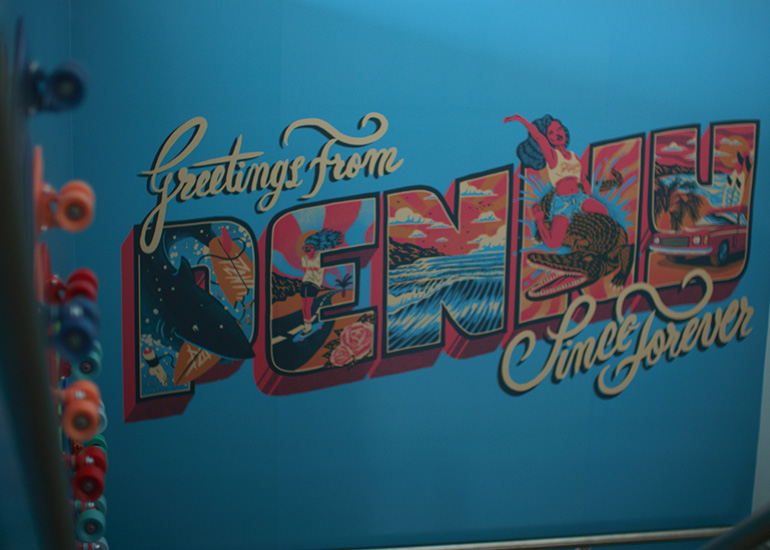Australian company Penny Skateboards is skating through their expansion into the US thanks to their decision to get on board with Amazon.
Penny Skateboards has been successfully operating since 2010, when founder Ben Mackay started manufacturing out of Brisbane. He named his unique boards Penny after his sister, a name that people soon started to associate with this style of plastic, smaller board. When your brand name becomes the generic name of a product, you know you’re onto a good thing.
You’re also onto a difficult thing, because when Penny Skateboards wanted to move into the US, how could they differentiate their product against cheaper, less quality competitors?
Being the only one coming up on a search engine surely helps.
The O.G. penny

Penny Skateboards are built with high-quality raw materials. Image: Supplied.
“We’re the O.G. penny. We have the Penny trademark,” says Nathan Reid, head of operations at Penny Skateboards. “And because we have that, we have ownership on Amazon. Any other competitors that use ‘penny’ in their product titles or descriptions, they’re not allowed to.”
This means that only Penny Skateboards comes up on Amazon when someone searches for the term. “People search for penny boards and our product is the only one that’s going to have the penny description. It gives us better ranking in Amazon that we don’t necessarily get in other search engines,” Nathan adds.
It’s one of the many reasons why things are working out so well for Penny Skateboards since they joined Amazon in late 2019.
Every day, Nathan carefully monitors the company’s progress in the Amazon Seller Central dashboard and things are looking good. In fact, that very dashboard has been another key to helping the team pilot the rise of Penny Skateboards on Amazon.
“Amazon manages all the heavy lifting for you,” says Nathan. “The recommendations that it offers for things like demand planning, inventory performance, even campaign suggestions really drive our next steps.”
Small changes making a big impact

Nathan Reid and Ben Mackay from Penny Skateboards. Image: Supplied.
When they started with Amazon, the team had no idea what they were doing, but made the decision to follow the recommendations given by Amazon and see what happened.
“For example, on your product listing it might say ‘Hey, out of these five products, we’ve seen that if you make a better product description it would improve the product ranking’ or ‘We’ve seen these products only have two images, we recommend three or four on this one’,” says Nathan.
Following the Amazon system recommendations meant they were continually improving at a pace they could set for themselves.
“It’s very guided, to help you help yourself,” he explains. “You essentially grow at the pace you can handle.”
Reliable fulfilment matters
This strategy is one Nathan recommends to anyone just starting out: get on there and then refine as you go.
“That kind of learning in Amazon is the biggest thing we took away from it when we were jumping on at the start and we used Amazon’s recommendations to drive our next steps. Taking their advice paid off, big time,” he shares.
The other aspect of selling on Amazon that has impressed Nathan and the team is the ease of fulfilment. They use Fulfilment by Amazon (FBA) to deliver their product to the customer and because they’ve been able to integrate their own e-commerce system with Amazon’s, it neatly switches over to Merchant Fulfilment should stock runs out at the Amazon warehouse.

Penny Skateboards are known for their colourful designs and design details. Image: Supplied.
Even during the peak of COVID, when demand for their product suddenly increased, it meant they never missed a sale and the customer experience was seamless.
“People know that if Amazon says you’ll get it the next day, you’ll get it the next day,” says Nathan. “There’s a reliability and trust that Amazon has built in fulfilment that’s even more important right now when there are fulfilment and carrier issues happening across the States.”
Set up shop where your market is
It’s the same reliability that first made Penny Skateboards aware that Amazon was where they needed to be to grow into other markets.
“Not being on that platform would really allow our competitors and other boards that were out there to really capture a lot of the market. We wanted to be on [the Amazon] marketplace to have a presence to start with. Once we could see what demand was, we thought we’d ramp up from there.”
Ramp it up Penny Skateboards did, using a range of Amazon marketing tools to refine and test optimal marketing campaigns. “There’s so much help and advice in their system about basic campaigns you can run, with wizards to walk you through,” notes Nathan.
As a result, they’ve seen major growth with $1.73 million in revenue from Amazon sales in the past 12 months.

Penny Skateboards is now a globally recognised brand. Image: Supplied.
In 2022, Penny Skateboards plans to move their Amazon relationship into new international markets.
Nathan has been impressed with how easy selling in the US with Amazon has been and he expects the same when they move into new countries.
“It’s given us the confidence to say we have five different places we want to put Amazon into Asia and Europe and the UK, because we know it worked [in the US] and how hands-off it is,” says Nathan. “I know I can probably set up a couple more and it wouldn’t put much more work on my plate than I already have.”
The plan is to do it the same way they started with the US market – get onto the platform and use the insights coming from Amazon Seller Central to improve and grow.
More than 11,000 Australian businesses of all sizes sell in Amazon’s stores. To join them, find out how to start selling on Amazon and the tools, features and resources available to help your startup soar.
Check out other Aussie sellers making it big on Amazon here: www.amazon.com.au/shoplocal.
This article is brought to you by Startup Daily in partnership with Amazon Australia.
Feature image: Supplied.





















Trending
Daily startup news and insights, delivered to your inbox.